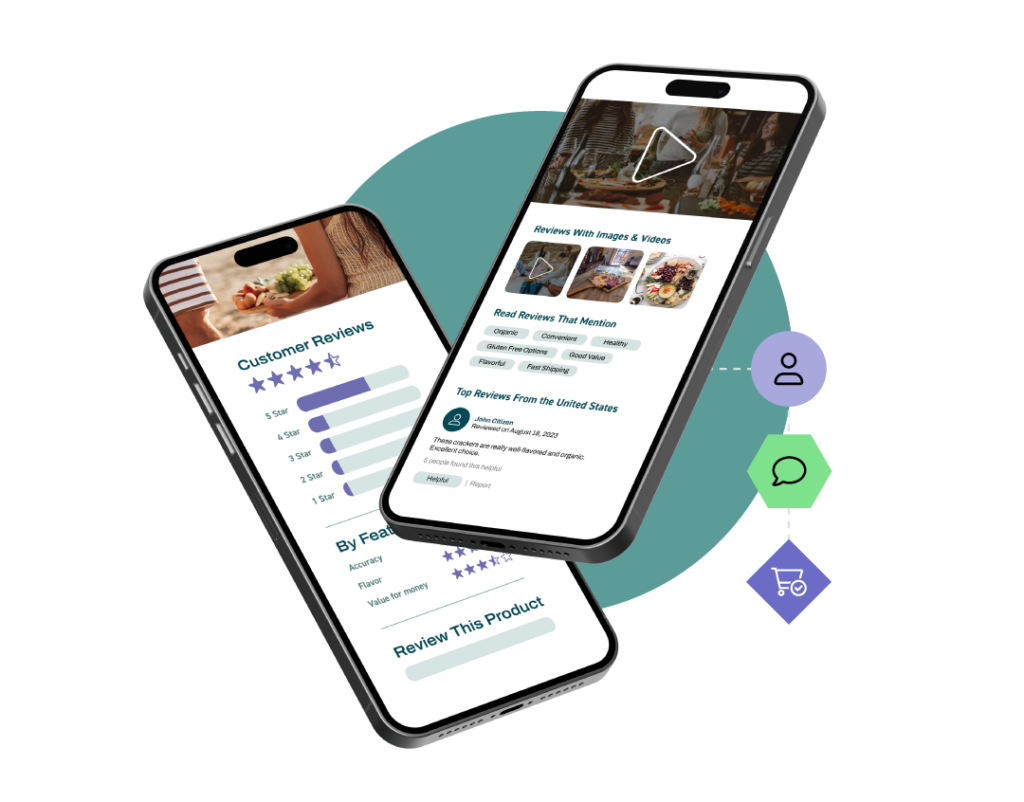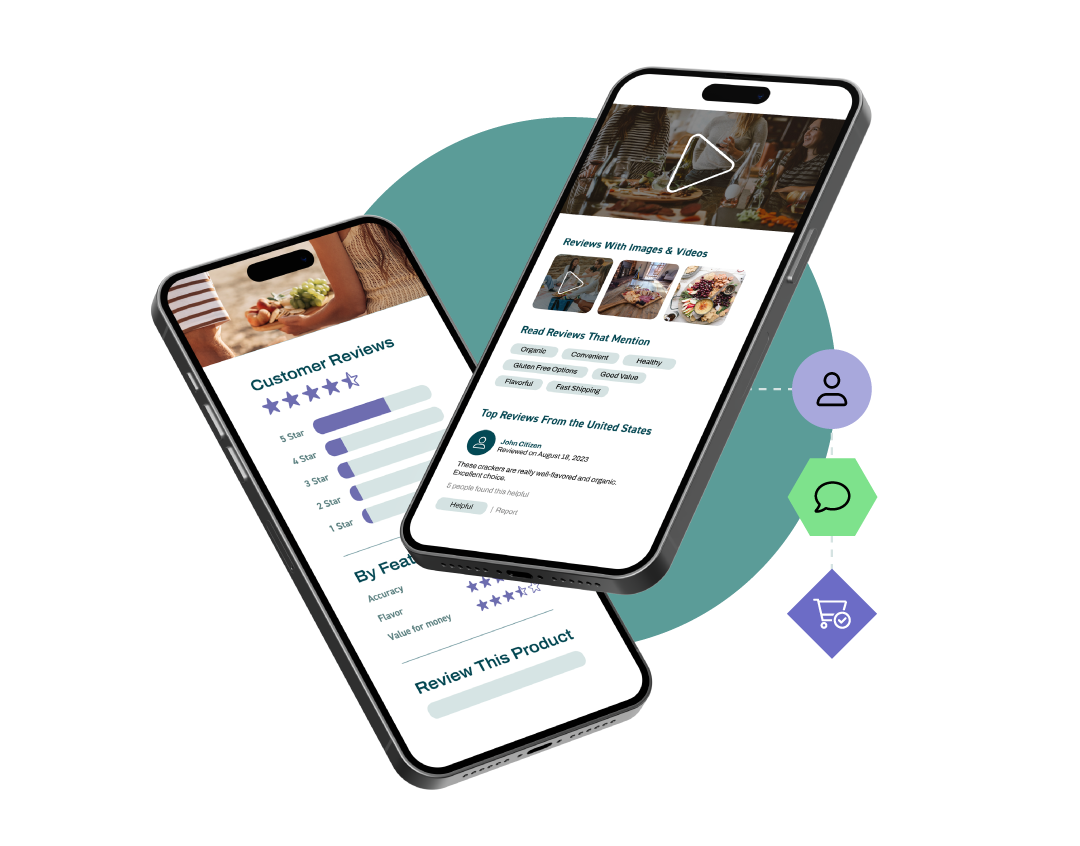User-generated content (UGC) is rapidly becoming a cornerstone of commerce. UGC impacts how consumers shop and what they buy. Are you curious about the growing impact of UGC and current shopping trends within the space? You’re not alone. Read on to discover the latest data surrounding UGC and its burgeoning importance for both e-commerce and in-store shopping.
1WorldSync’s 2024 Product Content Benchmark Report offers a clear look at how companies across industries like consumer packaged goods (CPG), retail and consumer electronics are managing product content. With insights into emerging trends, challenges and best practices, the report highlights how businesses can create product content strategies that build trust, increase engagement and drive conversions in an increasingly competitive landscape.
This article dives into the data specific to UGC and how it impacts purchasing decisions.
Key UGC Takeaways from the 2024 Product Content Benchmark Report
The 2024 Product Content Benchmark shows that UGC, including product reviews, ratings and customer photos, has become one of the most influential factors in the purchasing journey. According to the report, 88% of consumers say they actively seek out reviews before making a purchase, and businesses that incorporate UGC effectively into their product content strategy see notable improvements in customer engagement and sales performance.
Why Ratings and Reviews Are Essential
The PCB report reveals that 65% of shoppers often or always read reviews before making a purchase, underscoring the critical role that UGC plays in the buying process. Consumer reviews provide a level of transparency and authenticity that brand-provided content often cannot. They offer insights into how products perform in real-world scenarios and highlight potential issues that may not be evident from marketing materials alone.
In fact, 67% of shoppers say that ratings, reviews and customer-submitted photos or videos have persuaded them to make a purchase they weren’t initially planning. This data suggests that UGC doesn’t just validate decisions—it actively drives them. For many consumers, seeing real people use and review products helps bridge the trust gap, especially in a digital shopping environment where they can’t physically interact with items.
UGC is not just critical for online purchases. It’s increasingly critical for brands who are focused on brick-and-mortar retail, as well.
9 in 10 shoppers use smartphones while shopping in stores at least some of the time to find out more about products. On average, consumers use their devices on more than half of shopping trips (54%). So what are they looking for specifically? Price comparisons, leads the list, but 53% of shoppers say they look for customer ratings and reviews to narrow in their in-store searches.
The Power of Visual UGC
While text-based reviews are crucial, the PCB report highlights the growing demand for visual content from consumers. Nearly 1 in 4 shoppers would leave a product detail page (PDP) if it lacked consumer-submitted photos or videos. This trend is particularly prominent in categories where aesthetics, scale or product usage are important, such as fashion, home goods or electronics.
Shoppers are not only looking for detailed feedback; they want to see the product in action. 82% of consumers find customer-submitted video reviews helpful, indicating a strong preference for visual UGC. Videos can provide a much clearer representation of a product’s features, scale and quality, offering a more immersive shopping experience that text and photos alone cannot achieve.
Building Consumer Trust Through UGC
For brands, this reliance on UGC presents an opportunity to build deeper connections with their audience. Encouraging satisfied customers to share their experiences through reviews, photos and videos can help build credibility and drive conversions. UGC also has the added benefit of acting as social proof, helping to reassure potential buyers that they are making the right choice.
The report also shows that high-quality reviews are more than just feedback—they are persuasive tools. Consumers prefer reviews that are longer than 1-2 sentences, provide detailed insights, and include both the good and the bad aspects of a product. These reviews are seen as more trustworthy, allowing potential buyers to make more informed decisions.
Brands that understand the importance of UGC and foster a community of reviewers will be better positioned to capture and retain consumers. By integrating reviews and customer-submitted media into the broader content strategy, brands can create a richer, more engaging shopping experience that leads to greater customer satisfaction and loyalty.
Leveraging UGC for Maximum Impact
One of the standout findings from the report is the critical role that UGC plays in driving consumer trust and engagement. As shoppers continue to rely on the experiences and opinions of other customers, UGC has become a cornerstone of successful product content strategies.
Here’s how brands can harness the power of UGC to enhance their product content and better meet consumer expectations:
1. Collecting and Displaying Reviews and Ratings
Consumers look for authentic feedback when deciding which products to purchase. Displaying customer reviews and ratings on product pages not only builds credibility but also improves search engine visibility. The report highlights that businesses with a high volume of relevant reviews see significantly higher click-through rates and conversion rates.
Brands can optimize this by consistently collecting reviews after each purchase and ensuring that both positive and negative reviews are easily accessible. Not only does this transparency build trust, but it also provides valuable insights for brands on how to improve their products and services.
2. Syndicating Reviews Across Channels
To reach consumers where they shop, brands need to ensure that reviews and ratings are visible across multiple platforms. Syndicating this content to retail partners, e-commerce platforms and social media allows consumers to access consistent feedback no matter where they engage with the product. Brands that effectively syndicate reviews benefit from increased visibility and greater consumer trust.
By centralizing the management and distribution of reviews, businesses can maintain a unified and reliable customer feedback presence, which is crucial in an omnichannel environment.
3. Incorporating Q&A for Deeper Engagement
A frequently overlooked aspect of product content is the opportunity for consumers to ask questions and receive answers directly on product pages. The report indicates that customers are more likely to purchase a product when they feel confident that their concerns and questions have been addressed. A Q&A section can fill in the gaps that product descriptions may leave out, offering a more interactive and informative experience for shoppers.
Brands can manage this process by encouraging consumers to participate in the Q&A section and by ensuring that accurate, timely responses are provided. This not only supports the consumer decision-making process but also boosts engagement and improves product page SEO.
4. Leveraging Visual UGC
As shopping becomes more visual, many consumers prefer to see how products are used in real-life situations before making a purchase. Including customer photos and videos on product pages gives shoppers a more authentic sense of how a product looks and functions, which can influence buying decisions.
The report found that visual UGC significantly boosts engagement rates, with consumers spending more time on product pages that feature customer photos and videos. Incorporating these visuals helps create a richer product experience and builds a stronger connection with potential buyers.
Building a Holistic Product Content Strategy
While UGC plays a vital role in enhancing consumer trust and boosting engagement, it is just one component of a broader product content strategy. To create a seamless experience across all touchpoints, brands need to integrate UGC with other types of rich content, such as 360-degree images, product videos and detailed descriptions, while ensuring consistency across channels.
The 2024 Product Content Benchmark Report emphasizes that brands must be omnichannel-ready, distributing accurate and enriched content to all points of sale, whether online, in-store, or via third-party platforms. Having an integrated approach that includes everything from data syndication to content analytics allows businesses to fine-tune their product content strategy and ensure that they are meeting the needs of today’s informed consumers.
Implement Effective UGC Today
The insights from the 2024 Product Content Benchmark Report underscore the importance of delivering high-quality, trusted and engaging product content across the entire consumer journey. By incorporating user-generated content—such as reviews, ratings, Q&A and customer photos—brands can build stronger connections with consumers, enhance credibility and ultimately drive more sales.
As consumer expectations continue to evolve, businesses must take a proactive approach to managing their product content, ensuring that it is consistent, informative and omnichannel-ready.
To learn more about how your business can maximize the impact of user-generated content and elevate your product content strategy, reach out to 1WorldSync today and explore how PowerReviews can help you gather, manage and distribute reviews, Q&A and visual content across all touchpoints.






